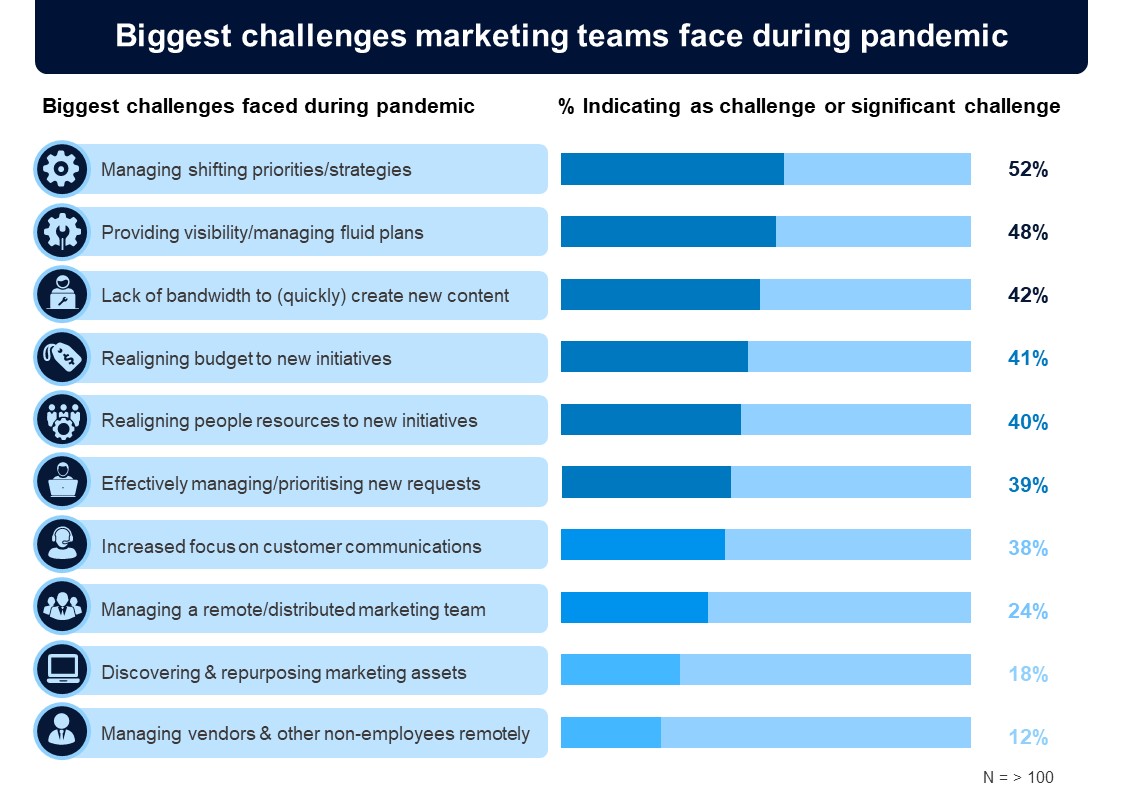Corporate
COVID-19 Impact: How CMOs can lead their teams to navigate rough waters and forge deeper connections with customers
The COVID-19 pandemic has caused disruptions, the kind never witnessed previously, across all facets of professional and personal lives. Tectonic shifts in the regular functioning of nearly all global economies and industries has brought about a ‘New Normal’, replacing ‘Business As Usual’. CMOs and their teams across most industries are faced with unprecedented changes to their day-to-day operations, mandating recalibration of strategy and tactics and reallocation of efforts and budgets, as well as tracking evolving customer habits. And, CMOs have to handle these while managing a large workforce of dispersed marketing teams that are operating remotely. While the full extent of the pandemic's impact on marketing is still being ascertained, CMOs need to urgently identify the signs and evaluate the factors that can assist them in steadying their ships in the short to medium term:
- How are customer habits changing?
- How are customers consuming marketing products and services?
- Where and on which channels are they spending most of their time?
- How can marketers be more productive and effective in the new normal?
- Do we need to change or optimise the communication strategy?
- How are my competitors reacting?
- How do I efficiently use my marketing dollars in the short term?
- What immediate measures need to be implemented so as to be competitive in the future?
These are a few challenges that all brand leaders, CMOs, and global marketing teams are tasked with finding answers to develop strategies for the future. This period of uncertainty could also potentially be a blessing in disguise for CMOs to rejig their internal structures, processes, and frameworks, as well as to test new ideas and innovate to serve customers more effectively once the pandemic has receded.

Biggest challenges marketing teams face during the pandemic (Source: NewsCred and Sirkin Research Survey)
What CMOs should do in a post COVID-19 world
1. Support and reassure employees first – equip them to suitably serve customers
With most marketing teams operating from the confines of their homes, loss of work productivity has become a real issue and a roadblock to operational efficiency. It is critical to first ensure that one's own employees are safe and sound and are reassured through access to support systems and remote collaboration tools and platforms to adapt to the new normal. In times of uncertainty, regularly communicate with employees to boost morale and support them to become more resourceful and productive to better serve customers.
2. Don’t stop the conversations – but use greater sensitivity and empathy while communicating
With the world embracing a new normal for some time to come, it is critical for brands to maintain and even enhance customer loyalty by forging deeper connections and communicating with them empathetically. As a step towards building trust, proactively inform employees and customers that their wellbeing remains a top priority. CMOs must revaluate marketing strategy and shift budgets (and not underinvest) to where customers now spend more of their time. According to a TechCrunch study, social media usage during the latter half of March 2020 and the total time spent on the most popular platforms have grown as much as 30–40% compared with pre-COVID-19 times. Marketing teams should continue to track user habits and dig deeper into their user data to retain existing customers by establishing one-on-one connections and delivering messages they are most likely to resonate with.
3. Pivot to relevant marketing mix at speed – embrace frugality
CMOs must prioritise upcoming campaigns and either pause or stop in-flight campaigns if they are irrelevant to these uncertain times. Repurpose existing assets to produce and deliver quick-turn campaigns frugally to reassure customers and deliver important communication around critical measures to counter the virus, safety measures, health-related information, etc. Keep a continuous tab on in-flight campaigns for relevance and pivot to the right channel mix accordingly. For example, JPMorgan Chase's wealth division adapted its ad messaging for TV broadcast (shifting from their traditional in-person events strategy) through a video campaign that was produced in-house in just 10 days using real financial advisors delivering a reassuring message to their clients.
4. Continuously update and refresh functional content – stay clear of exuberance
CMOs of large retail teams must especially have in place mechanisms to communicate changes in store timings, business hours, closures, and extended delivery timelines in a proactive manner. Alternative ways of enabling business transactions with customers must clearly be called out where relevant, especially for essential goods. Marketing operations teams must update product and services listings across all channels to improve customer experience and to remove or update any business details that may not be accurate in the current climate (e.g., scheduled in-person events, store operations, policies). From a visual communications standpoint, it is also critical to reevaluate all creatives and imagery already in use. Make sure to use the right tone, visuals, keywords, and ad placements for all creatives. For example, many large brands are using a more empathetic tone in their communications and are refraining from including loud content themes and imagery (fun, humour, celebrations, etc.) or those that aim to capitalise on the current crisis (e.g., price gouging). Most brands have stayed away from running viral campaigns and have rather pivoted towards providing customers with useful information, regulatory guidelines, and real-time updates.
5. Create and amplify pull and push content – get creative but not at the expense of diluting brand value
CMOs must encourage their teams to produce more content, especially the kind that will resonate with customers and alleviates their fears and anxieties. Update and refresh existing content (both pull and push content) and publish new content regularly across the right mix of channels where engagement is high. Research the latest content trends and keywords for inspiration. Mindshare India reports a surge of 20.5% in subscriber base on YouTube within 45 days of lockdown in India! COVID-19 related content has seen an almost 100% surge, while engagement is nearly 200%. Brands are expending greater efforts (through tactics like social commerce) to engage with users on Facebook and Instagram.
6. Embrace digitisation and say hello to virtual interactions – it’s never too late
In the B2B space, CMOs must embrace digital event management technology to reach customers. Prepare teams to conduct webinars as an effective marketing tool and replace large-scale in-person events with virtual events that can deliver cost efficiency even in the long term. Switch to collaboration tools and platforms that build connections for both employees and customers at home a lot easier. Going forward, brands can expect increased budgets for hosting digital events and those businesses that are best prepared to manage these in the future are more likely to be leaders and not just followers. As per a survey conducted by content marketing services leader NewsCred, 78% of marketing leaders expect a significant increase in the creation of virtual events and expect increased investments in virtual events, web content, webinars, social media, blogging, and video communications.
7. Future-proof marketing operations – but start piecing together the building blocks today
Equip marketing workforces with project management technologies and tools that manage resourcing through MRM (Marketing Resource Management) tools and content workflows through CMPs (Content Marketing Platforms). Early adopters of such investments will be better prepared to manage the current disruptions as well as the future ones. Enable teams to collaborate remotely and seamlessly, similar to how they would operate as soon as life is back to normal.
8. Keep an eagle eye not just on customer data but also on competition and their moves
Track customer behaviour closely and anticipate customer needs by monitoring data trends. Be proactive and deliver assurance rather than appearing to ‘sell’. Promote options that are safer and in the best interests of the customers. Extend a helping hand to customers wherever they are and provide them with the most streamlined way to consume your products and services. On the other hand, stay abreast with what competition is up to and react accordingly. Moving forward, understanding new customer behaviours will be key in driving successful marketing strategies.
Amplify customer centricity
Today, every brand (and CMO) is undeniably faced with uncertain times. Marketers and their remote teams are hustling to figure out the next best action in the new normal. Customer habits will continue to evolve on a daily basis, leaving CMOs and their teams to quickly figure out how best to adapt. Brands will need to wait and watch if customer behaviour reverts to their old pre-COVID-19 ways and if any new habits will become mainstream in the post-COVID-19 future, giving marketers new opportunities to tap into and deliver an even better CX. The true winners will be the ones that are best prepared to overcome the rough waters not just today but also once the pandemic subsides. A brand’s response to the current crisis can make a huge difference in determining how they'll be perceived by the customers in the longer run. It is essential for people to practice social distancing, but one thing is certain that now is definitely not the time for brands and CMOs to socially distance themselves from their most important asset — the customer.






